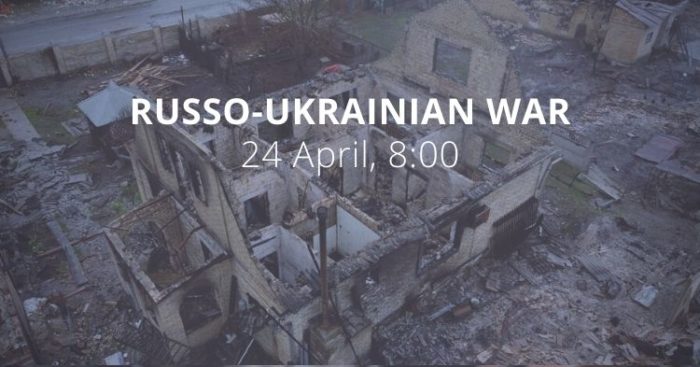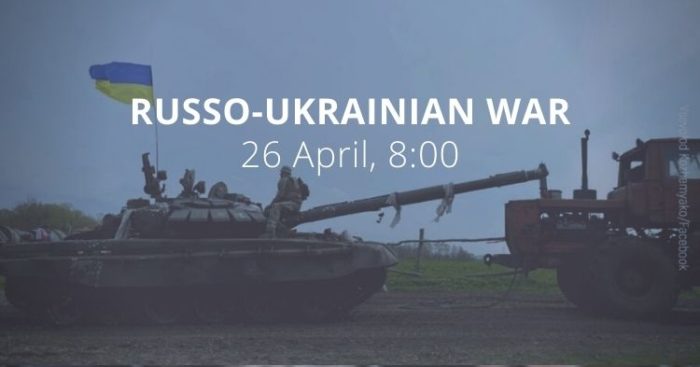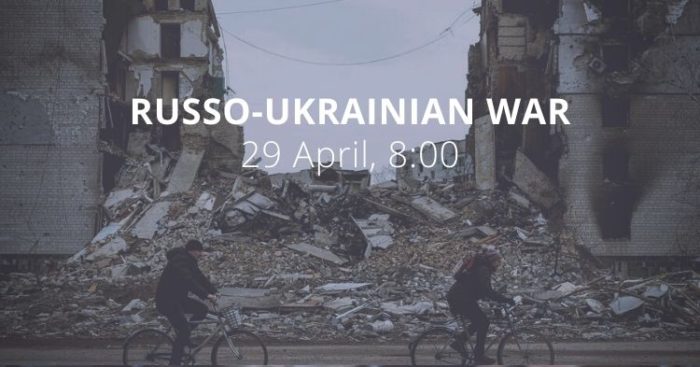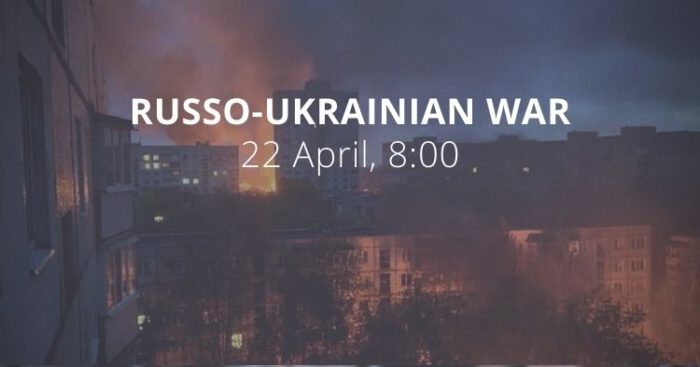Morning report day 60 – April 24
Situation
According to information from the General Staff:
Russian forces continue to conduct offensive operations in the Eastern Operational Zone to defeat the Joint Forces, establish full control over the territory of Donetsk and Luhansk oblasts and ensure a land route between these territories and the Russian occupied Crimea.
Russian forces are regrouping and expanding missile and artillery units to support the offensive and continue to launch missile and bomb strikes on military and civilian infrastructure.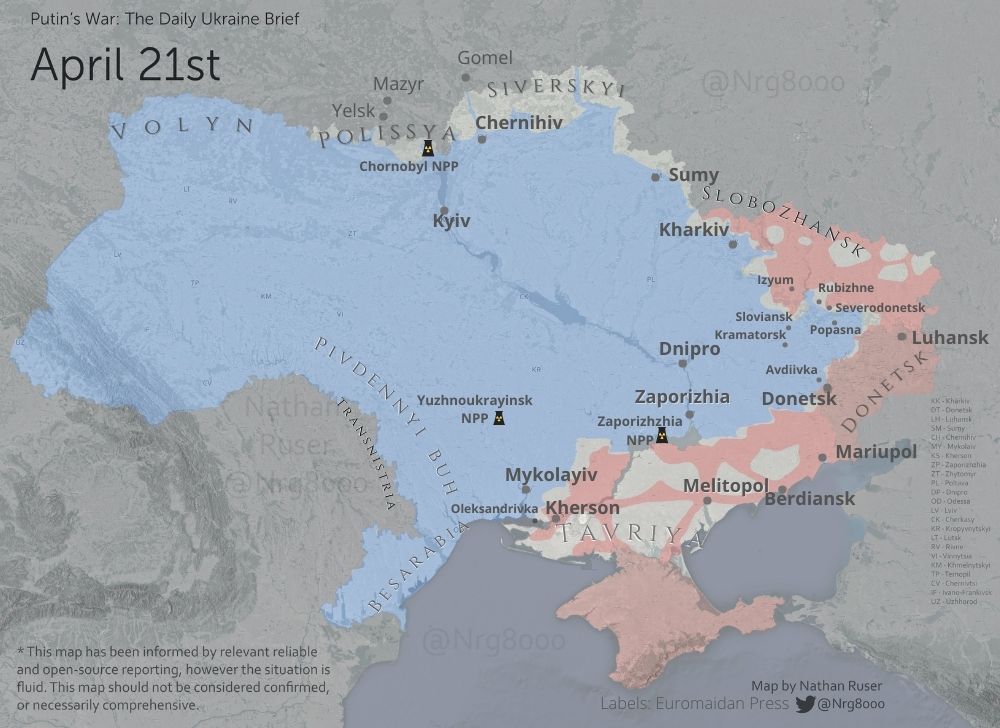
In the Volyn and Polissya directions, Russian forces did not take active action. Certain units of the Armed Forces of the Republic of Belarus continue to carry out tasks to cover the Ukrainian-Belarusian border in Brest and Gomel oblasts. In the areas of the settlements of Grabovka, Hlybotske, and Kalinino, Gomel Oblast, engineering of positions for equipment was carried out.
- No signs of the formation of Russian offensive groups were found.
In the Siversky direction, there are no significant changes. The FSS Border Service of the Russian Federation continues to provide enhanced protection of the Ukrainian-Russian border in the Bryansk and Kursk oblasts. Russian forces are increasing the engineering and fortification equipment of positions in the Bryansk Oblast at a distance of up to 3 km from the state border of Ukraine.
In the Slobozhansky direction, Russian forces increased the grouping of troops by transferring and concentrating additional units in the Belgorod Oblast. Thus, according to available data, 60 km from the state border of Ukraine deployed launchers of ground-to-ground ballistic operational-tactical missile systems 9K720 Iskander (SS-26 Stone).
- Russian forces continue to partially blockade Kharkiv, firing on units of our troops and critical infrastructure.
- In order to complicate the movement of units of the Defense Forces in the area of the village of Korotychi, Russian forces conducted remote mining.
- Russian forces are shelling the positions of Ukrainian in the areas of Kurulka and Nova Dmytrivka, conducting air reconnaissance of the positions of the Armed Forces of Ukraine with the help of the Orlan-10 UAV in the areas of Barvinkove, Kurulka and Husarivka.
- Russian forces continue artillery shelling of the positions of our units and civilian infrastructure in the area of the settlements of Chuhuiv, Korobochkino and Dovgenke.
In the Donetsk and Tavriya directions, Russian forces fire on the positions of Ukrainian troops with the use of mortars, artillery, and rocket-propelled grenades along the entire line of contact.
- It intensified offensive and assault operations in the Sievierodonetsk, Kurakhiv, and Popasna directions.
- There are battles in the areas of Zarichne, Rubizhne, and Popasna.
- In the Sievierodonetsk direction, the enemy launched pontoon crossings across the Krasna River.
- It is increasing the air defense system in the Avdiivka direction.
- In the area of Marinka and most other areas, Russian forces are unsuccessful in the course of hostilities.
- In the Mariupol direction, Russian forces continued to fire and blockade our units in the Azovstal area of Mariupol. Inflicts airstrikes, including from long-range aircraft. Using the railway connection, the enemy makes attempts to establish logistical support for troops.
Capt. Svyatoslav Palamar, Dep. Commander of the Azov Regiment from besieged Maripol:
"At this time, when you are sharing Easter pictures and enjoying the truce, the enemy drops bombs on the heads of innocent children in Mariupol."https://t.co/JCglt9eqOx
— Euromaidan Press (@EuromaidanPress) April 24, 2022
In the Pivdennyi Buh direction, Russian forces continue to hold their positions, in some areas it tries to improve the tactical position and exerts fire on the positions of units of Ukrainian troops and civilian infrastructure of Ukrainian settlements.
The Air Force of the Armed Forces of Ukraine, along with other anti-aircraft units of the Defense Forces, destroyed seventeen air targets the previous day: nine UAVs, three planes, and five cruise missiles.
Twelve attacks by the Russian forces were repulsed in Donetsk and Luhansk oblasts over the past 24 hours, four tanks, fifteen armored and four units of motor vehicles, and five artillery systems were destroyed.”
The Armed Forces of Ukraine have regained control over eight settlements across Ukraine’s southern Kherson Oblast
, according to Operational Command South, Ukrinform reports. Russian attempts at advancing to Oleksandrivka and Tavria were unsuccessful, as were the attempts to seize Mykolaiv.
- Ukrainian units in the area of Kyselivka opened fire on enemy forces preparing for the offensive. The Russians suffered heavy losses and retreated toward Chornobaivka.
- The Ukrainian military also recalled that on April 23, Russian Tu95 strategic bombers had launched missiles on Odesa. Three of the eight missiles were shot down, while the rest hit the city's infrastructure facilities, including a multi-storey apartment block and a cemetery. According to the latest update, eight people were killed by the strike, including a 3-month-old infant. Another 18 people were injured.
- 20 warships, including submarines carrying Kalibr cruise missiles, are operating in the Black Sea. They are blocking navigation in the area and conducting maritime and air surveillance. They are posing a threat of missile strikes almost throughout the entire territory of Ukraine.
- Odesa oblast experienced another missile attack from the sea after 22:00. Enemy missiles, fired toward the Pivdennyi seaport, were shot down by Ukraine’s air defense forces.
Ukrainian soldiers evacuated two children from Rubizhne who stayed under fire for a week on their own
Mykhaylo and Jason's mother went to town saying the boys to stay at home, and never returned. The brothers were evacuated to their relatives in Poltava.https://t.co/QW0rwY39PR pic.twitter.com/B6ACgmwKAo
— Euromaidan Press (@EuromaidanPress) April 24, 2022
The Ukrainian armed forces drove out Russian troops from 3 settlements in the Kharkiv oblast, Ukrainska Pravda reports citing the Head of the Kharkiv Regional Military Administration, Oleh Synegubov in the Telegram.
"We have good news from the front. Our Armed Forces carried out a successful counterattack and launched offensive operations against the enemy yesterday morning. Fierce fighting continued during the day. Sinegubov added that Ukrainian defenders also continue to hold defensive lines in the Izium direction”.
The Armed Forces of Ukraine destroyed a command operations center of the 49th Combined Arms Army of the Russian Armed Forces on April 22, Ukrinform reports citing DIU. As a result, two Russian generals were eliminated; one more enemy general was seriously injured and evacuated in critical condition. The personal data are yet to be reported.
Russia is continuing psychological operations to fuel panic in Ukraine, the Ukrainska Pravda reports citing the Centre for Countering Disinformation. On 23 April, the Russian Defense Ministry claimed that "the United States is preparing false flag operations in order to accuse the Russian military of using chemical, biological or nuclear weapons in Ukraine.
“According to the Russian military, "the most likely option is a false flag operation at chemical and biological facilities in Kharkiv and Kyiv, at Zaporizhzhia Nuclear Power Plant and radioactive waste storage in the settlement of Kamyanske. Ukrainian experts explain that the planting of such information is a part of the information and psychological warfare of the Russian Federation. It is aimed at instilling panic among Ukrainians, as well as putting pressure on the world community to reduce the level of support for Ukraine.”
Ukrainian General Staff has reported on the Russian manning and logistic challenges:
- According to available information, Russian forces have significant problems with the medical support of its units, there are difficulties with the evacuation of the wounded, and there is a lack of medicine. Due to the growing number of wounded, in the city of Balakliya, the enemy, along with the deployed military hospital, uses the capabilities of the city clinic.
- In the city of Vovchansk, which is temporarily occupied, junior medical personnel of health care facilities is forcibly sent to provide first aid to Russian units on the line of contact with the Defense Forces of Ukraine.
- Also, the Russian troops have significant problems with the replenishment of personnel, and attempts to forcibly mobilize residents of the Kherson Oblast to the Russian occupying forces continue.
- According to available information, Russian forces use civilian trucks to move military cargo in temporarily occupied territories. Also, Russian forces continue to use stolen agricultural machinery for military purposes.
The occupiers began forced mobilization, including medics, in the occupied territories of Kherson, Zaporizhzhia, and Kharkiv oblasts, the Defense Intelligence of Ukraine (DIU) claims. The occupiers are mobilizing Ukrainian medics who remain in the occupied territories. In particular, in the city of Vovchansk (Kharkiv Oblast), junior medical staff are forcibly sent to the front to provide first aid to the Russian wounded. In case of refusal, doctors are threatened with execution. Young people from the local population are also being targeted for mobilization. The possibility of leaving the Kherson Oblast for the territories controlled by Ukraine is almost completely blocked. The possibility of leaving for the Russian Federation is significantly limited.
“In the Zaporizhzhia Oblast, Russian servicemen and FSB officers are looking for conscripts. It is reported that they are to replenish the combat units of the Russian Federation in the most problematic areas. These measures are carried out despite the predominantly pro-Ukrainian attitude of the population of the regions and the general motivation to resist the Russian invaders.“
According to British Defense Intelligence, (last 24 hours):
- Ukraine has repelled numerous Russian assaults along the line of contact in the Donbas this week.
- Despite Russia making some territorial gains, Ukrainian resistance has been strong across all axes and inflicted significant costs on Russian forces.
- Poor Russian morale and limited time to reconstitute, re-equip and reorganize forces from prior offensives are likely hindering Russian combat effectiveness.
- The Ukrainian Main Intelligence Directorate and General Staff have accused Russia of planning to conscript Ukrainian civilians from the Russian-occupied Kherson and Zaporizhzhia oblasts. This would follow similar prior conscription practices in the Russian-occupied Donbas and Crimea.
- Article 51 of the Fourth Geneva Convention states “the Occupying Power may not compel protected persons to serve in its armed or auxiliary forces”, and “no pressure or propaganda which aims at securing voluntary enlistment is permitted”. “Protected persons” in this context includes civilians within occupied territories.
- Any enlistment of Ukrainian civilians into the Russian armed forces, even if presented by Russia as being voluntary or military service in accordance with Russian law, would constitute a violation of Article 51 of the Fourth Geneva Convention.
As of Sunday 24.04.2022, the approximate losses of weapons and military equipment of the Russian Armed Forces from the beginning of the war to the present day: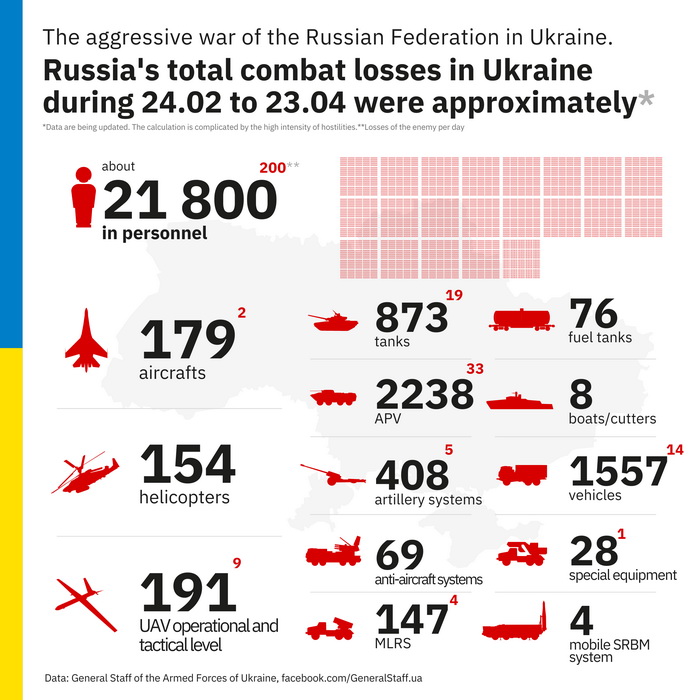
- Personnel – more than 21800 people (+200),
- Tanks – 873 units (+19),
- Armored combat vehicles – 2238 units (+33),
- Artillery systems – 408 (+5),
- Multiple rocket launchers – 147 (+2)
- Air defense means – 69 (no change),
- Aircraft - 179 (+2),
- Helicopters - 154 (no change),
- Automotive technology – 1557 (+14),
- Vessels/boats - 8 units (no change),
- Fuel and lubricant tanks – 76 (no change),
- UAV operational and tactical level – 191 (+9)
- Special equipment – 28 (+1)
- Mobile SRBM system – 4 (no change)
Humanitarian
According to UNHCR 5,163,686 refugees have been registered as of 22 April. The UN says that so far Poland has taken in 2,884,764 refugees, Romania 774,094, Russian Federation 578,255 (no changes since April 21), Hungary 485,618, Republic of Moldova 431,468 Slovakia 352,286 and Belarus 23,900 (no changes since April 21). Among those who fled Ukraine are also Ukrainian nationals with dual citizenship. An additional 105,000 people moved to the Russian Federation from the Donetsk and Luhansk oblasts between 18 and 23 February.
OHCHR recorded 5,381 civilian casualties in Ukraine as of 21 April. 2,435 have been killed (including 184 children) and 2,946 injured (including 286 children).
The government of Ukraine was still working to ensure humanitarian corridors to evacuate women, children, and the elderly from Mariupol, informing that foe was also preparing provocations against the agreed humanitarian route as of 23 April. According to the Deputy Prime Minister and Minister of Reintegration of Temporarily Occupied Territories of Ukraine:
“Today we will again try to evacuate women, children, and elderly people from Mariupol. If everything goes as planned, evacuation will start at 12:00 daytime next to PortCity shopping mall.”
The evacuation effort was sabotaged by Russian troops
, an advisor to the Mariupol City Major reported later the same day. He stated that occupiers brutally approached approx. 200 gathered to evacuate around 11 am on April 23, forcing them to leave amid expected shelling, and instructed to move to another one. Afterward, Russians said there was a different humanitarian corridor leading to Ukrainian-controlled territories. But once people took their places in the buses, foe troops reported that these buses would leave to the Russian occupied Dokuchaevsk, and forbade the passengers to leave transport, claiming that this happened because “nationalists shelled the first appointed evacuation venue”.
Legal
DIU has published the names and personal details of the 177th separate marine regiment of the Caspian flotilla (military unit 87852). The soldiers of the 177th regiment are suspected of committing murders and abuses of civilians of Ukraine as part of the 58th army in the Zaporizhzhia and Mariupol directions.
Berlin institute taps World War Two experience to document war crimes in Ukraine, the Reuters reports.
“The Pilecki Institute, named after a Polish cavalry officer who risked his life to document the situation in the Auschwitz concentration camp during World War Two, said it had started its own initiative to document war crimes through interviews with refugees. We are collecting all witness reports about war crimes in Ukraine relying on the experience we have as an institution that normally deals with...the voices of victims of the Second World War, Mateusz Falkowski, deputy head of the institute, told Reuters. More than 369,000 people fleeing the war in Ukraine have been registered in Germany, Interior Ministry data showed on Friday.”
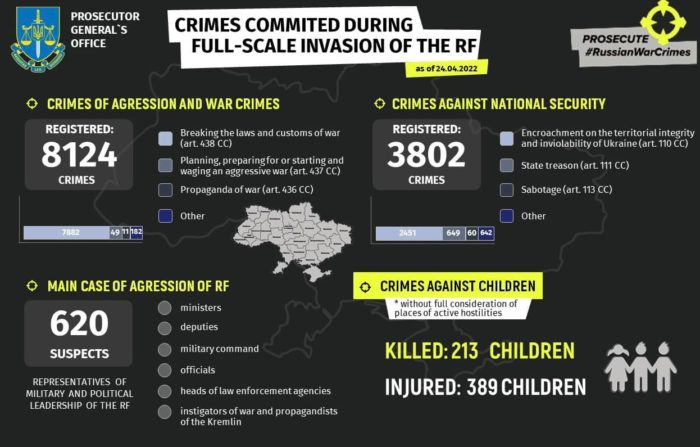 213 children are killed, and 389 children injured, the Office of the Prosecutor General of Ukraine reports as of 24 April. 1,500 educational establishments are damaged as a result of shelling and bombings, 102 of them are destroyed fully.
213 children are killed, and 389 children injured, the Office of the Prosecutor General of Ukraine reports as of 24 April. 1,500 educational establishments are damaged as a result of shelling and bombings, 102 of them are destroyed fully.
As of the same date, 7,124 crimes of aggression and war crimes and 3,802 crimes against national security were registered.
Environment
A third of gas exports to Europe via Ukraine are in danger due to Russian forces, the Reuters reports citing Naftogaz.
“One-third of gas exports from Russia to the European Union via Ukraine could be lost if Russian forces continue disrupting operations in newly occupied areas, the head of Ukraine's state energy firm Naftogaz said on Saturday”.
https://twitter.com/EuromaidanPress/status/1518120806311677953?s=20&t=b5ZIFjwCUx7bBMrvAyxewg
Support
Belgium to send anti-tank weapons and maybe artillery systems to Ukraine, Army Recognition reports. According to information published by local newspapers on April 22, Belgium will send new weapons to Ukraine including anti-tank weapons and is considering the possibility to provide M109 155mm tracked self-propelled howitzers.
The United States and the European Union are discussing ways to reduce Russia's oil revenues, the Economic Truth reports citing Bloomberg.
One of the US concerns is that a direct EU ban on Russian oil could lead to a sharp rise in prices and give the Kremlin even more revenue. US Treasury Secretary Janet Ellen said Thursday that a full embargo could cause serious damage to European economies but will not deal as hard a blow to Russia as expected. Any decision on the final measures will be taken by the EU member states.”
Since the launch of the full-scale Russian invasion, Poland has handed over more than $1.6 billion in defense aid to Ukraine. This was stated at a press conference by Prime Minister of Poland Mateusz Morawiecki, Ukrinform's own correspondent reports. “He noted that Ukraine has been defending itself extremely bravely for almost two months, although Russia planned to end the war in three to four days. They are fighting for us, for Europe, for freedom, for peace in Europe, and let everyone be aware of that," said the head of the Polish Council of Ministers.”
New developments
- Russian disinformation and a potential indication of a forthcoming False-flag operation: “The US and NATO move to the final stage of plotting provocations in Ukraine”:
- Russian Foreign Ministry Spokeswoman Maria Zakharova claims that Washington’s initial plan involved economic pressure on Russia to make Moscow "completely reconsider legitimate interests in the security sphere." "It didn’t work out. Now the US is moving on to involving the weapons of mass destruction (WMD), practically - to the games beyond the ‘red line’," the spokeswoman stated.
- The United States is preparing provocations to accuse the Russian side of using chemical, biological, or tactical nuclear weapons, Chief of Russian Radiation, Chemical, and Biological Protection Force Igor Kirillov claimed on Saturday. He claims that the Russian Ministry of Defense has “information about the United States preparing provocations to accuse the Russian Armed Forces of using chemical, biological, or tactical nuclear weapons". According to Kirillov, the plan is “a reaction to Russia’s success in the special operation”.
- Kyiv pushes for more weapons before expected visits by top US officials, the Washington Post reports. US Secretary of State Antony Blinken and Defense Secretary Lloyd Austin are expected to visit Ukraine on Sunday in what would be the highest-level visit by an American delegation since the start of the war. “They should not come here with empty hands,” President Volodymyr Zelensky said during a news conference in a subway station in Kyiv. “We are expecting specific things and specific weapons.” The trip would mark two months since Russian forces invaded Ukraine, where fighting is intensifying in the southern and eastern parts of the country.
- President Zelensky believes that Ukraine must use every opportunity to negotiate with the Russian Federation until the war ends, Ukrinform reports. During the same press conference, however, he also stated that Ukraine will retake everything Russia occupy quickly, but only if we have enough weapons. As soon as we have enough weapons, we will immediately retake this or that temporarily occupied territory," President of Ukraine Volodymyr Zelensky said at a press conference on April 23, an Ukrinform correspondent reports.
- As Western Arms Pour Into Ukraine, Zelensky Promises Victory, The New York Times reports. President Zelensky, bolstered by an influx of heavy weapons from Western nations, expressed increasing confidence on Saturday that Ukraine was prepared to defeat Russian forces in what is expected to be a long and brutal battle for control of the eastern industrial heartland. “We will be able to show the occupiers that the day when they will be forced to leave Ukraine is approaching, Mr. Zelensky said in an overnight address to the nation. The statement seemed to mark a decisive shift for Mr. Zelensky, who has spent months begging and shaming allies around the world to provide Ukraine with longer-range, heavy weapons to repel Russian forces as they assault the east in the latest offensive in the two-month-old war.”
- Minister for Foreign Affairs of Ukraine Dmytro Kuleba has called for recognizing Russia as a sponsor of terrorism after today’s missile strikes on Odesa, Ukrinform reports. "The only aim of Russian missile strikes on Odesa is terror. Russia must be designated a state sponsor of terrorism and treated accordingly. No business, no contacts, no cultural projects. We need a wall between civilization and barbarians striking peaceful cities with missiles," the minister said.
- Türkiye closes air space to the Russian military, and civilian jets heading to Syria, TASS reports. Türkiye closed its air space to Russian military and civilian planes flying to Syria, Turkish Foreign Minister Mevlut Cavusoglu told journalists during his Latin American tour. "We were giving permissions in three-month intervals. The latest one was until April, the Sabah newspaper quoted him as saying. The Turkish top diplomat stated that President Recep Tayyip Erdogan had informed his Russian counterpart Vladimir Putin about the situation. Henceforth the flights have stopped, he added, saying that the process is being conducted through dialogue on both the Montreux Convention and other matters.”
- Russian forces have taken SMM staff members captive in eastern Ukraine, Ukrinform reports. “We have received alarming reports that Russia’s proxies in Donbas are threatening Mission staff, equipment, and premises and that Russian forces have taken SMM staff members captive. We condemn these threats to this Mission and its dedicated personnel in the strongest possible terms. We call for the release of SMM staff members, as well as all Ukrainians detained by Russia, Deirdre Brown, Deputy Head of UK Delegation to OSCE, said at the OSCE Permanent Council meeting on April 22”.
- Russia investigates media reports on the presence of British SAS special forces in Ukraine, Reuters reports. “The Special Air Service is an elite military force trained to conduct special operations, surveillance and counter-terrorism. Russia's RIA Novosti news agency on Saturday quoted a Russian security source as saying about 20 SAS members had been sent to the Lviv Oblast. A spokesperson for the British Ministry of Defense said: "We do not comment on Special Forces." It was not clear what steps the Investigative Committee planned to take in response to any SAS involvement in Ukraine. But the fact of the investigation into the possible presence of forces from a NATO country is significant.”
Russia launched missile strikes on Odesa today.
Part of the missiles was downed. At the same time, videos by locals showed explosion in residential areas. Official information about victims is yet to come.https://t.co/DFx4cFVsTP
— Euromaidan Press (@EuromaidanPress) April 23, 2022
Assessment
On the War
The Institute for the Study of War has made the following assessment as of Saturday 23 April:
The Russians have not taken time to refit troops moving from Kyiv or Mariupol before recommitting them to combat operations. They are not pausing offensive operations to wait until they have concentrated overwhelming combat power, and they do not appear to be massing forces on a few decisive axes of advance. They are continuing the pattern of operations they have followed throughout the war: committing small collections of units to widely dispersed attacks along multiple axes and refusing to accept necessary operational pauses to set conditions for decisive operations. Russian forces have thus far only committed a handful of battalion tactical groups (BTGs) to offensive operations in their various sectors, however, and could still launch a massed offensive operation. We assess that such an operation is unlikely given observed patterns and the inherent limitations of available actual combat power in troops that have fought hard and suffered many casualties, as well as observed challenges with command-and-control at the regiment/brigade and division level. It is possible that the Russians are addressing or attempting to address some of those challenges and will soon launch an offensive in a new and better-coordinated form, but it remains unlikely. The objectives of Russian offensives around the Izium-Donetsk City salient are unclear. Russian forces may seek to reach the Izium-Debaltseve road along two or more axes to encircle a large concentration of Ukrainian forces and built-up areas. Ukrainian officials suggested on April 23 that Russian forces near Rubizhne and Popasna may seek to encircle the Sievierodonetsk-Lysychansk area rather than pursue the deeper envelopment. It is too soon to evaluate the likelihood of this Russian course of action or the probability of its success. Russian forces continued to attack Ukrainian defenders in the Azovstal Steel Plant and are likely attempting to starve out those remaining within the facility. Advisor to the Head of the Ukrainian President’s Office Oleksiy Arestovych stated that Russian troops tried to storm the plant and “strangle” Ukrainian resistance, though ISW cannot independently verify this claim. Russian forces allegedly organized buses for civilian evacuation from Mariupol but canceled the evacuation on the grounds that Ukrainian ”nationalists” were planning on attacking the civilians. Such actions that spoil the evacuation process likely represent further attempts to shape the information space in Mariupol and globally, as well as to extend administrative control in captured portions of the city. Key Takeaways Consequences and what to do? Ukrainian leaders were 'desperate' to buy UK weapons to help defend against Russia after the Crimea invasion but were turned away by three successive Prime Ministers over fears they may provoke Vladimir Putin, the Daily Mail reports citing a former defense minister. “Ukrainian leaders were 'desperate' to buy weapons from the UK following Russia's invasion of Crimea in 2014, but were turned down by three successive prime ministers, it was claimed last night. Former defense secretary Sir Michael Fallon told the Sunday Times how concerns over provoking Vladimir Putin appeared to trump the plight of the Ukrainian leadership. When serving under former Conservative prime minister David Cameron, for example, he claims he was told to turn down requests for assistance in upgrading Ukraine's defenses despite the Ministry of Defense wanting 'to do more'. He said this policy was in place for seven years and was only lifted in the weeks before the invasion in February of this year. He added that during his years as defense secretary, between 2014 and 2017, Ukraine was 'desperate' to buy British weapons. He said: 'They wanted almost everything. They were not able to resist the incursions into Donbas. At times they had little more than rifles.' But the policy initiated by Cameron's government, he claimed, was to not send any lethal weaponry to the country. This was adhered to by his successor Theresa May, who in November 2017 accused Russia of running malign cybercampaigns 'to sow discord in the West and undermine our institutions'. However, she made it clear she did not want to alienate Russia and cause another Cold War, adding: 'So while we must beware, we also want to engage, which is why in the coming months the foreign secretary will be visiting Moscow.' Even Mr Johnson sought a 'normalization' of relations with Moscow when he was foreign secretary in 2016 - which was after the illegal annexation of Crimea, the shooting down of the Malaysia Airlines Flight MH17, and the Kremlin's military support for President Assad's bloody regime in Syria. In stark contrast to today, Mr. Johnson was vocal about sending only non-lethal military equipment to Ukraine, despite calls from his colleagues to give the former Soviet state weapons that might have actually deterred Russian attacks. But according to the Sunday Times, such calls were ignored and the policy of sending real arms and weaponry to Ukraine was not lifted until a few weeks before the invasion this year. It suggests Mr Johnson's government, too, rejected Ukraine's pleas for weapons until very recently.” The story told by the Daily Mail reflects the attitude of most of the capitals across NATO for the last 8 years. I know from my own experience as a Defense Attaché, participating in multinational meetings with the Ukrainian Armed Forces that all NATO nations received continuous Ukrainian requests for both lethal and non-lethal aid from 2014 and onwards. As records shows, Ukraine received its first batch of weapons first 4 years after the active phase of the Hybrid War started in 2014. The fact is that we were played by the Russian Federation for 8 years, and we have yet to admit it. As a consequence, we signed on to a “peace agreement” (Minsk agreement) that could never create the basis for a peaceful resolution of the war, but that also stopped the West from helping Ukraine rebuild the Armed Forces and re-establish deterrence. We stuck to our script of a “diplomatic solution” to the conflict, taking the military option off the table already in 2014. Our joint strategy inherently resulted in Ukraine remaining vulnerable, while the aggressor prepared for the ensuing full-scale war. I have several times been asked if the war could have been avoided, and my response has always been a “yes, definitely, but no”. We could have stopped a low-intensity hybrid war turn into a regional conflict because we for 8 years watched Russia develop its military capabilities, militarize Crimea, relocate Land Forces closer to the Ukrainian border, become increasingly aggressive in the Sea of Azov and the Black Sea and little by little, integrate Belarus into the Russian Federation. During the period, Russia did not only maintain its strategic aim and objectives but became increasingly belligerent in its rhetoric towards both Ukraine and the West. Equally important, the list of Russian violations of international law grew every year. Its strategic documents became more and more threatening and hostile. The reason we were unable to stop the war from happening was due to a combination of lack of strategic thinking and strategic thinkers in national capitals, widespread risk and casualty aversion, peacetime thinking – or what James Sherr calls a crisis management paradigm - and institutional weaknesses. Additionally, the Russian Federation has been able to mess with the heads of key decision- and policymakers. Decades of the Russian Hybrid War still influence Western thinking. But most importantly, the war is a consequence of 15 years of lack of resolve, lack of will and ability, and not at least, for not properly responding to Russian belligerent actions across Europe and the USA. From the very start of the war in 2014 crisis management was our proper business. “On 24 February the ‘crisis’ ended, and war began. From day one, it was clear that for Ukraine to survive, Russia would have to be defeated.” However, as James Sherr points out, “if you believe in crisis management, then Russia cannot be defeated without its consent”. In my opinion, after 2 months of war and atrocities – more than 8 years of war - several countries are still in a “Crises Management Mode” believing that Russia can be persuaded to stop the war and give up Ukraine (or worse still, for Ukraine to “compromise”, creating the foundation for continued war). As I have previously argued, we are partly to blame that President Putin was surprised by our resolute and unprecedented response to Russia’s full-scale invasion of Ukraine. To avoid further “surprises” we need to adapt our messaging and actions to ensure Russia knows we mean business. Bringing the NATO military options back on the table is the most efficient means to avoid further escalation and a broader military confrontation. Start the planning. Make the official statements. Move the required forces closer to the theatre. Approach the UN to start the process of establishing the basis for an UN-mandated humanitarian intervention and a No-Fly Zone. Do whatever is needed to demonstrate resolve, will, and ability.
Assessment by Hans Petter Midttun

